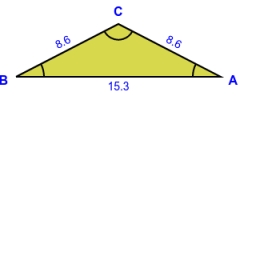Isosceles + prism
Calculate the volume of the perpendicular prism if its height is 17.5 cm and the base is an isosceles triangle with a base length of 5.8 cm and an arm's length of 3.7 cm.
Final Answer:

Tips for related online calculators
Tip: Our volume units converter will help you convert volume units.
See also our right triangle calculator.
Calculation of an isosceles triangle.
See also our trigonometric triangle calculator.
See also our right triangle calculator.
Calculation of an isosceles triangle.
See also our trigonometric triangle calculator.
You need to know the following knowledge to solve this word math problem:
algebrasolid geometryplanimetricsUnits of physical quantitiesGrade of the word problem
Related math problems and questions:
- Isosceles triangle
 Calculate the size of the interior angles and the length of the base of the isosceles triangle if the arm's length is 17 cm and the height of the base is 12 cm.
Calculate the size of the interior angles and the length of the base of the isosceles triangle if the arm's length is 17 cm and the height of the base is 12 cm. - Height—the 6183
 In the isosceles trapezoid ABCD, the base length is a = 10cm, c = 6cm, and the arm's length is 4cm. Calculate its height—the result round to tenths.
In the isosceles trapezoid ABCD, the base length is a = 10cm, c = 6cm, and the arm's length is 4cm. Calculate its height—the result round to tenths. - Perpendicular 35183
 Calculate the surface and volume of a vertical prism if its height h = 18 cm and if the base is an equilateral triangle with side length a = 7.5 cm.
Calculate the surface and volume of a vertical prism if its height h = 18 cm and if the base is an equilateral triangle with side length a = 7.5 cm. - Calculate 258
 Calculate the volume and surface area of a prism with a trapezoidal base and a height of 9 cm. The base is an isosceles trapezoid with bases of lengths 3 cm and 6 cm and arms of length 2.5 cm. The height of the base is 2cm.
Calculate the volume and surface area of a prism with a trapezoidal base and a height of 9 cm. The base is an isosceles trapezoid with bases of lengths 3 cm and 6 cm and arms of length 2.5 cm. The height of the base is 2cm. - Base of an isosceles triangle
 Calculate the size of the base of an isosceles triangle; the height is 5 cm, and the arm's length is 6.5 cm. What is the perimeter of this triangle?
Calculate the size of the base of an isosceles triangle; the height is 5 cm, and the arm's length is 6.5 cm. What is the perimeter of this triangle? - The regular
 The regular triangular prism has a base in the shape of an isosceles triangle with a base of 86 mm and 6.4 cm arms; the height of the prism is 24 cm. Calculate its volume.
The regular triangular prism has a base in the shape of an isosceles triangle with a base of 86 mm and 6.4 cm arms; the height of the prism is 24 cm. Calculate its volume. - Perpendicular prism
 Calculate the volume of the vertical prism if its height is 60.8 cm and the base is a rectangular triangle with 40.4 cm and 43 cm legs.
Calculate the volume of the vertical prism if its height is 60.8 cm and the base is a rectangular triangle with 40.4 cm and 43 cm legs.
